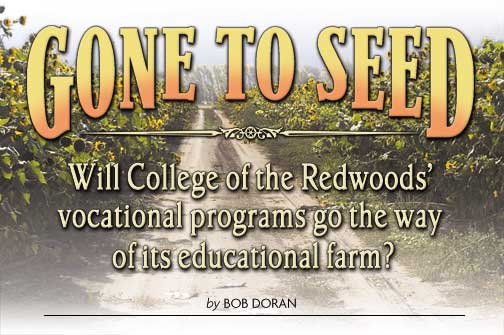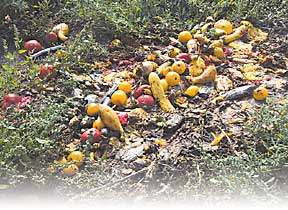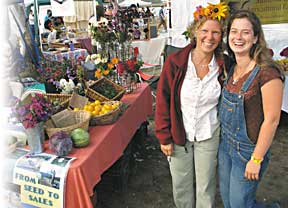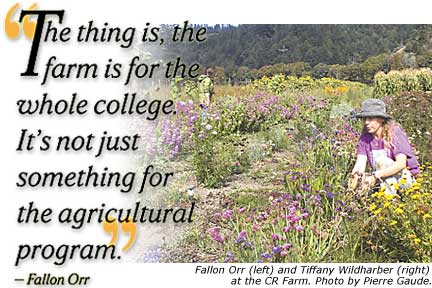|
COVER STORY | IN
THE NEWS | STAGE
MATTERS | OFF
THE PAVEMENT October 12, 2006
Tory and Tiffany set straight to work. The 18-year-old grabs a tub from the back of the truck and heads off to the corn patch while his mom harvests some brilliantly yellow crookneck squash. She stops to point out rows of chard, zucchini and carrots, thriving tomato plants, potatoes ready to dig. Even an untrained eye can see that the soil is
good here -- the lush crops confirm it -- but amid the bounty
you can also see the unfulfilled potential. Then there's the
long row of broccoli gone to seed. A line of cucumber plants
ready for picking is littered with over It's a learning experience for the women. This is the College of the Redwoods' Sustainable Organic Agriculture Farm, and the two of them make up most of the enrollment in a CR Agricultural Enterprise class that uses the farm as a laboratory. It's a Wednesday, so the day's activities include selling at the produce stand they set up in the school's quad two days a week. On Sundays and Mondays they assemble boxes of vegetables for a couple of dozen households that have signed up for a Community Supported Agriculture (CSA) program, each paying $400 to get organic produce throughout the growing season. Left: Bounty from the CR Farm. Photo by Bob Doran. On the other side of a dirt road are more fields with winter squash, pumpkins and alfalfa that are maintained by farm manager Franz Rulofson and students from another CR class, a lab on sustainable agriculture. Rulofson and his family live across a redwood-lined creek spanned by a plank bridge. The area known as the upper field holds a small barn and a few outbuildings where donated farm machines wait for operators. A new greenhouse and the beginnings of an apple orchard suggest recent activity. Rusting antique equipment left over from the previous owner show that this place has a long history as a working farm. A long history, but an uncertain future. As the bolted broccolis and the rest of the rotting produce testify, the CR administration's enthusiasm for the farm -- never high to begin with -- has been waning still further in recent years. Acting CR President Jeff Bobbitt, who took over the helm of the school when former president Casey Crabill left for a job in New Jersey earlier in the year, has inherited a school in decline as is case with Humboldt State University, enrollment at CR is falling. Classes are being cut; programs are being scaled back. Here in Shively, with the bounty of harvest season springing forth from the soil, the value of the educational farm is plain. In fact, though, with all that wasted produce going back to the earth the farm could be taken as a bellwether of the College of the Redwoods and its changing purpose. Is it still a place where people can learn a trade where they can get their hands dirty? Or is that part of the college's mission due for pruning?
He had no know connection to the college and apparently left the land to the school in his will to spite a neighbor who had his eye on it. To make sure the neighbors did not get his land, he was very specific: He mandated that CR must use the property for agricultural education. If the college did not want it, it would go to the Save the Redwoods League to be planted with redwoods and turned into a park.
Right: Excess produce composting at the CR
Farm. There was originally some discussion about whether or not the school should take the gift. Shively is a long way from the main campus and there was uncertainty about how the farm would be integrated into the curriculum. Samson came up with a plan of sorts: The college could accept the bequest and sell the farm, then use the money to support the agriculture program, thus fulfilling the intent of the will. The probate court did not agree. A protracted legal battle ensued. That battle was still being fought when Jeff Bobbitt joined the CR administration in spring of 1997. Cedric Sampson was still college president, but he left the following year, and after a 12-month search Casey Crabill was hired to take his place. (When Crabill left CR earlier this year to take a position at another college, Bobbitt left his position as vice president of academic affairs to take over as CR's acting president.) One of Crabill's first actions was to resolve the legal fight over the Shively farm. "When Casey came in, our only desire about the farm was to get the issue settled," Bobbitt recalled in a recent conversation. "That was one of the first things we worked on, trying to get a positive resolution to any lingering questions about the farm. Casey put the word out to the whole community asking for [input]." An advisory committee was established, and it offered recommendations. In February 2000, the CR board of trustees finally chose a plan put forward by Bert Walker and John Wrigley, both full-time agriculture teachers at the time -- to use the Shively farm as a working component of the college's agricultural program. Walker was excited at the prospect. "I'm a farm boy, and I'd lived down there -- the climate's good, the soil is spectacular -- so I thought it would be a great opportunity," he said recently. "There were all sorts of things the farm could do." As Bobbitt recalled, the farm needed a lot work. "The college invested significant time and energy and money in bringing the infrastructure up to speed," he said. Franz Rulofson was hired as farm manager in 2001 and brought his family to live on the farm in Bianchi's old house. He noted that his first task was to clear the overgrown property. While the ag teachers, Walker and Wrigley, had come up with the proposal, once the farm was established they were not allowed to offer much further input. Under the administration's version of their plan, all Walker was allowed to do was take classes to the farm for field trips. "[Bobbitt] separated the agricultural instruction program from the farm very firmly in a memo," said Walker. "The instruction on campus was a plant science horticulture program, mainly. I was not permitted to serve on the farm advisory committee or to have any say in the management or operation of the farm." Farm management was solely Rulofson's responsibility. He also became overseer for the agricultural enterprise program, supervising the students and acting as liaison for CSA customers, something he does to this day along with teaching labs for the sustainable ag class.
Wildharber and Orr are believers in the CR ag program. When they were at the farm that morning, they spoke with what bordered on evangelic fervor about the what they'd learned. It was clear that they were frustrated: They were running the farm garden pretty much on their own, and felt that the college was not giving adequate support to the farm, or to the ag department in general.
Left: Tiffany Wildharber and Fallon Orr serve as ag ambassadors at the Organic Planet Festival. Photo by Bob Doran. With a touch of southern drawl, Orr described the agriculture department's potential for recruitment from a personal perspective. "I moved here from Tennessee for the ag program," she said. `I thought, wow, I can live by the ocean and the redwoods and learn about farming, and the farm's organic. It just seemed like a good thing to do, and here I am." This is Wildharber's second year for enterprise ag. She explained that the way the class is set up, the participants get to keep half the money they take in -- the rest goes to support the farm -- but it does not amount to a whole lot. Her first year she took home $3,000 for untold hours of labor, her own and her teenage sons'. "It's kind of nutty for me to do it again considering the time commitment, but I'd even do it again if they'd pay me better," she said. She'd also like to see the college offer more academic credit for the enterprise class. "It's a year-long commitment and we spend a lot of time on it, but all of our work only earns us two units," she said. "That's something they should change." How much time do they spend? "A lot," said Orr with exaggerated emphasis, and both women laughed. "We work four days a week, about eight hours a day," said Wildharber, and Orr added, "And that doesn't include the driving. I travel 300 miles a week." The gasoline bills have been particularly brutal
this season, and the money comes out of their end; the college
does not reimburse for travel. As summer wore on they stopped
going to the Garberville Farmer's Market, then Ferndale. Sales
at those markets barely paid their gas expenses. "What we need is a vehicle to transport us from the school to the farm back to market, to deliver to the market," said Orr. But time, money and credits are not their primary worries. Last spring Wildharber met with Bobbitt, then CR's vice president of academic affairs, to express her concern for the future of the ag program in general, and in particular the fact that since Bert Walker retired in 2004, his position had not been filled. "They've parceled his classes out to three part-time faculty," she recalled telling Bobbitt. "There's no one to provide continuity. Everyone's wondering what's going to happen to the program." She was not reassured by Bobbitt's response. She recalled: "He said he'd seen this before, not necessarily with the ag program. But when any program looses an instructor, students worry about their program. He told me a couple of times, `You probably care about this more than I do.'" She left the meeting feeling that the administrator did not really recognize the importance of the college ag program. "He asked me what I wanted to do with my ag degree," she recalled. "I said I'd like to farm. He said, `If you just want to farm, you don't need a degree do you?' "You know when you're taking those classes you only need to get the degree, accounting and things like that, you wonder about that. It just made me mad that he said that." (Walker disagrees with the idea that farmers don't need education -- he said that studies have shown that about 64 percent of California's farmers have college degrees.) Orr and Wildharber concede that the farm program could use more participants. That's why they've been serving as ambassadors. "I think what the program needs is marketing," said Wildharber. "I'm in a marketing class, using it as a project. Fallon is using it in her business class, looking at that angle." CR's public relations department did actually put some energy into creating a marketing campaign a couple of years ago. There are brochures pitching the CSA and laminated signs to be used with the produce stand. They even produced a video about the farm. What effect it all had is hard to gauge. Wildharber thinks more needs to be done. "I have this dream, that the whole college takes a semester to support the farm: get a construction class to help build a bathroom, a wiring class to help with the electric part, a marketing class to get the word out so we get more students," she said. "The thing is, the farm is for the whole college," added Orr. "It's not just something for the agricultural program." Their vision of an interdisciplinary approach to the farm is not new. When CR took over the farm in 2000, a press release described it as a "laboratory setting for agriculture production courses in addition to a variety of forestry and natural resources classes," adding, "The farm would also involve CR students taking classes in construction technology, small engine and diesel repair and welding technology to upgrade farm equipment and other property. Geology, biology, environmental science and art students may use the setting for field-work."
It goes on to lay out advice in bullet points, advice that pretty much coincides with what the students have requested:
The report also suggests an outreach program for recruitment and a niche-marketing promotion of the college based on the theme of "sustainability," along with improving counsel services for "all vocational technical programs." Further recommendations include combining the agriculture and forestry/natural resources programs into a single department and that the "school farm should be recognized as part of the agriculture department." Bobbitt has read the report and distributed copies among the faculty and the ag community in general. (Despite the fact that the report is public record, he declined our request for a copy. It wasn't hard to find one, though.) Bobbitt offered no solid plans for implementing the committee's recommendations. As to the farm, in his analysis the key problem is "location, location, location." "I wish we had a bigger, critical mass for the agriculture program and for the farm," he said. "But my firm belief is that 90 percent plus of the [farm's] problem is location and transportation.' Could the college provide transportation to the farm? "We haven't found a way to do that yet," he said. As to filling the full-time ag position, he said it was not his decision, deferring to the faculty's academic senate, which is currently in the midst of the annual hiring process. Choices for new hires will be made at the senate's upcoming meeting on Friday, Oct. 20. The full-time ag position is one of 13 under consideration. But when it comes to filling new positions, Bobbitt says the college has to take into account limits on its resources and make allocations accordingly. "Like many of the California community colleges, we've been in a state of enrollment decline," he noted. "So we have a number of programs that used to have higher enrollments than they do now." The bottom line: "Every academic decision has some financial component to it."
The end result is a shift in the college's core mission away from vocational training programs toward a program of general education aimed at students who will continue their education elsewhere. "I don't think that the community had that in mind at all when they established the college," said Walker. "It was sold as a vocational college, and with Measure Q, they emphasized that in their advertising." (The ballot language for the $40 million regional bond measure bond passed in 2004 stated the money was "to finance specified improvements to school facilities, in order to strengthen local job and vocational training programs, and increase academic classes.")
After spending three decades teaching agriculture, Walker fears for the future of his old department, but he's just as worried about what seems to be a redirection of the school's resources. "We had so many instructors in the vocational ed area, and now most are gone," he said. "Not every student who goes to College of the Redwoods is going further. Not everyone who wants to be a diesel mechanic, a farmer, an electronics technician or a forester needs to get a bachelor's degree; they want enough technical skills to enter their field." Left: Jeff Bobbitt. Photo by Bob Doran. In his defense, Bobbitt contended that the departments that prep kids for a four-year university are there, in part, to support the vocational programs. "Every college uses big enrollment in popular general education areas to support courses that have to be smaller in more specialized occupational areas ... small programs that are expensive to maintain," Bobbitt said. "Agriculture with the farm is one of ours. It's not the only one. But the way colleges support that is by large enrollments in courses and program that are not expensive to maintain. The worst-case scenario is that enrollments in the small programs decline while the rest of the college is in general decline. That's what's been happening the last few years." As a result, tough decisions must be made. Bobbitt's hope is that no program suffers. "In any school if the enrollment continues to decline it becomes harder and harder to support every program," he said. "But as long as we maintain our base enrollment funding, our goal would be to maintain all of the occupational programs the students need." When we spoke with Bobbitt a few weeks ago, figures for current enrollment were not finalized. Now they are, and it doesn't look good. The trend has continued downward, both in headcount (the total number of students) and FTE (full-time equivalent). This year's CR class is 11 percent smaller than last year's. Fewer students means less money coming in, which presumably translates as fewer new hires for full-time positions. Walker is especially worried that the agriculture position will not be filled and there will be no one to speak out in support of ag classes in general. He ties it back to the farm. "I believe that killing the agriculture classes is a way to get rid of the farm," he said. He said that the farm had always been a "political hot potato," one that could pull down the whole ag program. But that would only be the case if the farm were defined narrowly, he said. "The farm is not the agricultural program," he insisted, "it is an instructional site that's available for any discipline at College of the Redwoods. I don't think they've explored all of their options." Walker suggested that the farm could be used for more "passive enterprises." "It doesn't have to be a vegetable farm or a hay farm," he said. "There's the potential to raise more timber or Christmas trees; there's an apple orchard on it, and as time goes on it should generate some small revenue." What does Bobbitt imagine CR will do with the farm, in the long run? Nothing's certain yet, but he doesn't rule out the possibility that the college could eventually let it go, handing it off to John Bianchi's back-up organization -- the Save the Redwoods League. It might just be too expensive for CR to maintain. "If we had a farm that could grow money," Bobbitt said, "we wouldn't have this problem."
COVER STORY | IN
THE NEWS | STAGE
MATTERS | OFF
THE PAVEMENT Comments? Write a letter! © Copyright 2006, North Coast Journal, Inc. |


 grown cukes rotting between
the rows. "We put in way too much and couldn't keep up,"
says Tiffany. "It's kind of a shame. A lot has gone to waste."
grown cukes rotting between
the rows. "We put in way too much and couldn't keep up,"
says Tiffany. "It's kind of a shame. A lot has gone to waste." According
to retired CR agriculture instructor Bert Walker, when Bianchi
died and it came time to receive the bequest, "There were
a lot of fits and jerks" on the part of the college. "The
college president then, [Cedric] Samson, wanted to sell it, but
there was a clause in the will saying it could not be sold, rented,
leased etc. to any of the neighbors. He didn't trust them, particularly
one he called `the greedy neighbor.'"
According
to retired CR agriculture instructor Bert Walker, when Bianchi
died and it came time to receive the bequest, "There were
a lot of fits and jerks" on the part of the college. "The
college president then, [Cedric] Samson, wanted to sell it, but
there was a clause in the will saying it could not be sold, rented,
leased etc. to any of the neighbors. He didn't trust them, particularly
one he called `the greedy neighbor.'" A
few weeks later, at their vegetable stand near the CR bookstore,
they were still feeling positive about the program, but no less
frustrated. They offered numerous ideas for improvement, from
bringing in new students to strengthening the ag curriculum.
A
few weeks later, at their vegetable stand near the CR bookstore,
they were still feeling positive about the program, but no less
frustrated. They offered numerous ideas for improvement, from
bringing in new students to strengthening the ag curriculum.
 "It
sounds like Dr. Bobbitt's mission is to prepare people to go
on to do something else," Walker continued. "The college
has definitely moved away from the vocational areas into general
ed."
"It
sounds like Dr. Bobbitt's mission is to prepare people to go
on to do something else," Walker continued. "The college
has definitely moved away from the vocational areas into general
ed."
